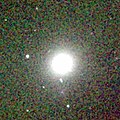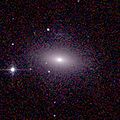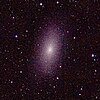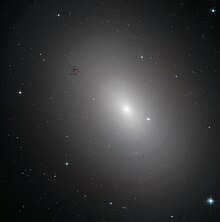Elliptical galaxy

An elliptical galaxy is a galaxy that differs from other galaxy shapes in the Hubble Sequence in its even distribution of light and the lack of conspicuous structures as in spiral galaxies . Elliptical galaxies are among the oldest star populations in the universe. It is now assumed that they have already gone through various merging and interaction processes with other galaxies. They usually consist of old stars and hardly contain any interstellar gas, as this was used up a long time ago. Therefore the star formation rate is very low. These galaxies are surrounded by a large number of globular clusters . The mass range of elliptical galaxies begins with small dwarf galaxies with a few million solar masses and reaches values of up to several trillion solar masses in central cluster galaxies . Within a radius of around 30 million light years around the Milky Way , around 34 percent of the galaxies are spirals, 13 percent ellipses and 53 percent are irregular and dwarf galaxies.
morphology
Classification according to the Hubble scheme
Elliptical galaxies are relatively bright in their center, with an initially rapid and then slower brightness decrease towards the outside. The lines of equal brightness (isophotes) can be described quite precisely by concentric ellipses . In the Hubble sequence, elliptical galaxies are divided into classes E0 (circular) to E7 (strongly flattened) according to the shape of these ellipses. The number added to E is determined as , where a is the size of the major and b is the minor axis of the ellipse. It should be noted that the classification also depends heavily on our viewing angle of the galaxy.
M 89 type: E0
Messier 32 type: CE2
NGC 4125 type: E6
Subdivision
In addition to ellipticity, elliptical galaxies can also be classified based on other properties:
| designation | description | absolute brightness | Mass range | example |
|---|---|---|---|---|
| E. | Normal ellipses (E): This class also includes the giant ellipses ( gE: giant ellipticals ) and the compact ellipses (cE: compact ellipticals ) | −15 to −23 | 1 · 10 8 to 1 · 10 13 M ☉ | Galaxy Messier 86 of type E3 |
| CD | These are extremely massive elliptical galaxies and have a bright, elliptical core with a diffuse halo of stars. They are mostly located in the center of a galaxy cluster. Their brightness falls outward more slowly than in E-galaxies. | −22 to −25 | 1 · 10 13 to 1 · 10 14 M ☉ | Elliptical galaxy ESO 325-G004 in the galaxy cluster Abell S740 |
| dE | Dwarf ellipticals (dE: dwarf ellipticals ): These are dwarf galaxies with an elliptical shape. However, they have different properties than normal ellipses. B. the surface brightness and luminosity different. | −13 to −19 | 1 · 10 7 to 1 · 10 9 M ☉ | NGC 205 , a companion galaxy to the Andromeda Galaxy . |
| dSph | Dwarf spheroidals (dSph: dwarf spheroidals ): They have a lower luminosity and have so far only been found in the local group . | −8 to −15 | 1 · 10 7 to 1 · 10 8 M ☉ | NGC 147 , a dwarf galaxy near the Andromeda Galaxy |
| BCD | Blue compact dwarfs (BCD: blue compact dwarfs ): These small galaxies contain large numbers of young, hot, massive stars. They contain a lot of gas. They can be identified by an emission spectrum that is typical for them. | −14 to −17 | approx. 1 · 10 9 M ☉ | The irregular dwarf galaxy NGC 1705 |
Brightness distribution
If you create a brightness profile of an elliptical galaxy by measuring the brightness with the distance to the center, then this course follows a De Vaucouleurs profile . This expresses a linear relationship between the logarithm of the intensity and the distance to the center.
The analysis of the brightness distribution is one of the most important tools to determine the properties and the evolution of elliptical galaxies. With this analysis technique, the lines of equal brightness ( isophots ) are assigned ellipses. The center points of the ellipses thus determined are usually very precisely centered in the center of the galaxy. However, the ellipticity can vary with the radius. The ellipticity derived from this and the angle of the major semi-axis provide basic information about the galaxy, e.g. B. the effective radius, triaxiality or a possible isophotic twist (isophote twist). In the case of an isophotic rotation, the angle of the major semiaxis of the ellipse changes with increasing radius. The brightness distribution of a galaxy can show a deviation from the ideal shape of an ellipse. There are boxiness and diskiness systems. These distributions give important information about the physical properties of an elliptical galaxy.
physics
composition
Elliptical galaxies are mostly made up of older Population II stars, which is reflected in the fact that they are reddish in color. Small, lower-mass ellipses can also contain younger stars (less than 5 billion years old). It used to be assumed that these galaxies contain next to no gas and dust. However, through observations in the X-ray range, one could also discover hot gas with a mass of several million solar masses. In addition, up to 50% of the galaxies contain a higher proportion of dust. Here the dust forms a ground plane together with an embedded star disk. This can be interpreted as an indication of earlier galaxy collisions.
Central black hole
Since the late 1990s, observations have shown more and more clearly that in the center of every elliptical galaxy and every bulge of a spiral galaxy there is a black hole that has a few per thousand of the mass of the elliptical galaxy or the bulge. This relationship, called the M-Sigma relation, has been found in elliptical galaxies with a mass range of 1 · 10 6 to 1 · 10 10 solar masses.
The processes in the formation and development of galaxies and black holes that lead to this relationship are still unclear. However, the black holes appear to play an important role in the evolution of elliptical galaxies.
Rotation and orbits of stars
In the past, it was often assumed that this flattening is caused by rotation and that elliptical galaxies are spherical or flattened ellipsoids of revolution. This has now been recognized as not generally applicable. Especially among the most luminous elliptical galaxies there are no or only little rotating systems that still appear flattened. The orbits of the stars are not ellipses or other closed shapes, but the stars move independently in all main axes. Its 'triaxial' expansion, i.e. different expansion in three spatial directions, arises from a directional dependence of the scattering of the speeds of its stars, i.e. an elliptical galaxy is not stabilized by rotation, but by the chaotic movement of the star gas. This star gas is in a relaxed state, which is not reached by collisions, but by violent relaxation .
Faber-Jackson relation
With the Faber-Jackson relationship there is an empirical relationship between luminosity L and the velocity dispersion σ in elliptical galaxies. This relationship is particularly advantageous because the speed spread of the stars can be determined relatively easily using spectroscopic analyzes. The distance to the galaxy can then be calculated using the absolute brightness determined.
Box-like and disk-like systems
By analyzing the brightness distribution, it was found that many elliptical galaxies do not show the ideal shape of an ellipse. Depending on the course of the isophotes, these can be divided into box-like ( boxy shape ) and disk-like ( disky shape ) systems. It has been shown here that further physical properties depend on this subdivision.
About 70% to 90% of the elliptical galaxies are disk-like, while 10 to 20% show a box-shaped structure. The box-like systems have a greater mass to luminosity ratio than the disk-like ones. With the disk-like systems, the rotation is more shaping than with the box-like ones. So here an orderly movement component predominates that does not exist in the other type. The disk-like systems are weak radio emitters, while the box-like type has a wide distribution of radio luminosity. There is a similar picture in the X-ray range. In the box-shaped galaxies, nuclei have often been discovered that move against the general direction of rotation ( counter-rotating cores ).
Shell structures
In some elliptical galaxies shell structures (are shells ) has been discovered in the form of arcs in the outer regions of the galaxy. The arcs are centered on the center of the galaxy. These structures can be recognized by contrast-enhanced images.
These shell structures in elliptical galaxies are likely remnants from galactic encounters. The most widely accepted theory for this is the accretion of small satellite galaxies along a trajectory that leads them towards the galaxy's center. Stars from this predecessor galaxy are released during their passage through the pericenter. These stars then form the shell structures when they reach their apocenter (i.e. the point in their orbit furthest from the center of the galaxy).
This model can be used to show that the previous galaxy has to go through a few passes before it dissolves. This can explain why the shell structures are so far away from the galaxy, which is observed in many galaxies with shell structures. The captured galaxy loses energy through dynamic friction. The outermost shells are created first, the inner ones at a later point in time, when the precursor galaxy has already lost its kinetic energy.
Properties of a galaxy such as box-shape, shell structures, and opposing nuclei suggest that it is a result of a completed merger of two or more galaxies.
Halo
Elliptical galaxies are surrounded by diffuse stellar halos and a large number of globular clusters. While in spiral galaxies it is very easy to deduce a proportion of dark matter in the halo based on the rotation of the galaxy, this is not possible with elliptical galaxies, since there is no clear rotation movement.
By analyzing the X-rays of the hot gas, a high proportion of dark matter in the halo of elliptical galaxies could be discovered. B. for the galaxy NGC 4472 a dark matter proportion of approx. 90% has been determined.
Fundamental level
The fundamental plane is a relationship between the effective radius, the average brightness and the general velocity spread of normal elliptical galaxies. These three parameters are interdependent, so one parameter can be calculated as soon as the other two parameters are known. In a three-dimensional coordinate system, the measured values of the parameters of different elliptical galaxies form a plane.
Occurrence
The proportion of elliptical galaxies in the total number of galaxies is highly dependent on the environment. In rich galaxy clusters , almost half of the galaxies are elliptical, while the proportion in regions of low galaxy density falls below 10%. In the center of many galaxy clusters there is also a particularly massive elliptical galaxy or a similar galaxy shape known as a cD galaxy.
There are many similarities between somewhat fainter elliptical galaxies and the central bulges of spiral galaxies. A distinction must be made between elliptical galaxies and the faint spheroid dwarf galaxies, which are also elliptical in shape but follow different relationships between brightness and size.
Emergence
Most of the stars in elliptical galaxies are old. Elliptical galaxies also usually contain very little interstellar matter from which new stars could form. Because of their age and their high central star density, it has often been assumed that elliptical galaxies were formed around 10 billion years ago by the rapid collapse (monolithic collapse) of a single large gas cloud. The gas is used up to such an extent that no more stars can form later. However, this idea can only explain the slight rotation of many elliptical galaxies with difficulty and is not well compatible with a basic assumption of today's cosmology , namely that structures such as galaxies arise through the merging of smaller units.
In addition, there are indications from observation and theory that an elliptical galaxy is formed when two spiral galaxies merge. In such a large collision, the galaxies change completely. The disks are completely destroyed, their stars receive very different speeds and directions and are distributed in space. The disruption of the gas orbit leads to increased star formation (starburst). The gas is heated up or ejected so strongly that no more stars are formed.
This would also explain the existence of counter-rotating nuclei found in every third galaxy. However, this mechanism cannot explain all properties of all today's elliptical galaxies. The period and mechanism of formation of elliptical galaxies are still the subject of intensive research and are not necessarily the same for all such galaxies.
Web links
Individual evidence
- ↑ a b c d e Johannes Feitzinger : Galaxies and Cosmology . Ed .: Franckh-Kosmos. 2007, ISBN 978-3-440-10490-3 , pp. 75 .
- ^ A b c d e Peter Schneider: Introduction to extragalactic astronomy and cosmology . Springer Verlag, 2008, ISBN 978-3-540-30589-7 , pp. 90 .
- ↑ Lecture slides by Harald Lesch
- ↑ Black Holes USM
- ↑ Colliding galaxies create black holes
- ↑ othes.univie.ac.at (PDF; 6.2 MB)
- ^ Galactic onion. NASA, May 11, 2015, accessed October 3, 2015 .
- ↑ M. Bílek et al .: Deep imaging of the shell elliptical galaxy NGC 3923 with MegaCam . May 28, 2015, arxiv : 1505.07146v1 .
- ↑ ifa.hawaii.edu (PDF; 48 kB)
- ↑ Peter Schneider: Introduction to Extragalactic Astronomy and Cosmology . Springer Spectrum, 2008, ISBN 978-3-540-30589-7 .
- ^ Elliptical galaxies on the USM











